10 Stunning Projects Win Structural Steel Industry Design Awards
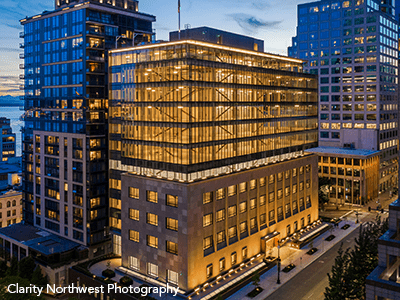
CHICAGO – The jury has spoken, and 10 projects across the country have won 2023 Innovative Design in Engineering and Architecture with Structural Steel (IDEAS²) Awards!
These awards, presented annually by the American Institute of Steel Construction, are the industry’s most prestigious design honor, recognizing projects that illustrate the exciting possibilities of building with structural steel and highlight the many ways steel can help express architectural intent while harnessing its unique advantages for both simple and complex structural systems.
This year’s winners are an intriguing mix of adaptive reuse and brand-new structures.
“I love how this year’s winners not only use steel to create modern masterpieces but also take full advantage of steel’s unique ability to give a second life to structures that would otherwise be demolished,” said AISC President Charles J. Carter, SE, PE, PhD. “Half of the projects that won this year use steel to reinvent structures that have been part of a community for decades or even a century. It’s wonderful to see steel preserve the character of a community by preserving its structures.”
Two of these existing structures–Seattle’s Federal Reserve Building and a brick industrial space in San Francisco–needed substantial work to bring their seismic systems up to code. Steel turned a 20th-century post office into a 21st-century transportation icon in New York.
In Seattle, steel allowed for a near-total demolition of the interior of Climate Pledge Arena–while keeping the roof and facade in place–and in Milwaukee, steel kept the music playing at an aging venue by literally raising the roof.
Bridging the gap between old and new, one brand-new structure finally brings a 1952 Ludwig Mies van der Rohe design to life, seamlessly bringing the striking design into compliance with modern building requirements. In Inglewood, Calif., steel allows a massive new stadium to feel light while allowing movement in the event of seismic activity.
In California’s Orange County, steel serves as an inspiring canvas for an art museum, while a steel gives zoo visitors in St. Louis a lemur’s-eye view of the world. And a new terminal at DFW is impressive not only for the experience it gives travelers but also for the way it landed: in large, modular sections.
This year’s winners will be featured at NASCC: The Steel Conference, April 12 to 14 in Charlotte, N.C.
LESS THAN $15 MILLION
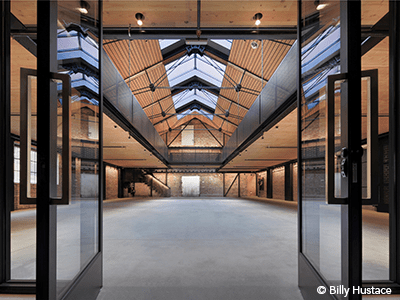
National Award: MacLac Building D (Rebirth of a Historic Paint Factory), San Francisco
Airy steel trusses and a new mid-height structural mezzanine add state-of-the-art seismic resistance to an unreinforced brick factory from 1906–preparing it for another century of service.
Owner: Comstock Realty Partners, Los Angeles
Architect: Marcy Wong Donn Logan Architects, Berkeley, Calif.
Structural engineer: Gregory P. Luth & Associates, Inc. / GPLA, Santa Clara, Calif.
General contractor: RHC Construction, Oakland, Calif.
Consultant: Mark Hulbert Preservation Architecture, Oakland, Calif.
Judge comment: “What stood out to me on this project is how successful they were at highlighting the existing structure. The brick is beautiful now. It’s 100 years old unreinforced, but it wouldn’t have been a very good lateral system for this building nowadays, especially in San Francisco. So they put it in moment frames that don’t hide anything. They added a new CLT diaphragm to the floor. They reused old timbers and the trusses for the compression element in the top where you need something stocky but took advantage of steel for the tension bottomed portions of the trusses–a thin, sleek design, something you could only have done in steel that completely lets your eye pass to the historic pieces of the building that remain.” -Jim Foreman, PE, SE, senior project engineer, Martin/Martin Consulting Engineers
Merit Award: The Eskenazi School of Art, Architecture + Design, Bloomington, Ind.
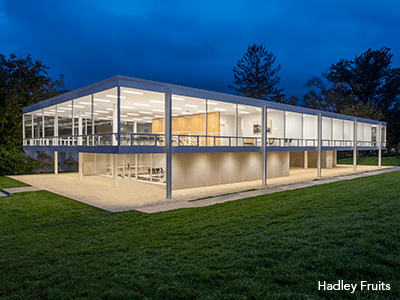
In 1952, Ludwig Mies van der Rohe designed a house for the Pi Lambda Phi fraternity on the main campus of Indiana University in Bloomington, but funding cuts relegated the plans to the MoMA archives. Exactly 70 years later, students now get to enjoy that space–not as a fraternity house, but as a design school.
Owner: Indiana University, Bloomington, Ind.
Architect: Thomas Phifer & Partners, New York
Structural engineer: Skidmore, Owings & Merrill (SOM), Chicago
General contractor: CDI Inc., Terre Haute, Ind.
Judge comment: “It’s amazing to see that the team was able to honor the original design that Mies had. You can’t separate the idea of steel and the idea of that building–steel is the only thing that could make that building work. When it’s executed at that level, with that sensibility for detail and attention to the original intent of the architect, it’s a magical experience to see a building come together like that.” -Anders Lasater, AIA, architect and principal, Anders Lasater Architects
$15 MILLION TO $75 MILLION
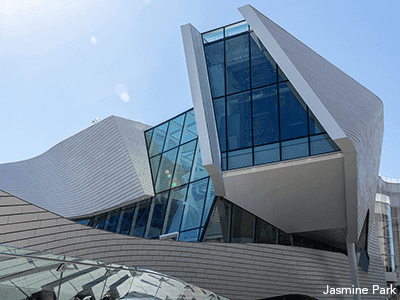
National Award: Orange County Museum of Art, Costa Mesa, Calif.
A flowing, irregular structure houses intimate small galleries, a reconfigurable main exhibition space, and a rooftop terrace for large-scale sculptural works.
Owner: Orange County Museum of Art, Costa Mesa, Calif.
Architect: mOrphosis Architects, Culver City, Calif.
Structural engineer: John A. Martin & Associates, Inc., Los Angeles
General contractor: Clark Construction Group, Irvine, Calif.
Judge comment: “The use of steel throughout the building is both obvious and in some ways obfuscated, which told the jury that the architect and the structural engineers really understand the unique qualities and material capabilities of structural steel and found ways to use it to their design advantage–not just as a structural solution, but really more as a way of expressing and hiding the structure to play with the visitor’s ability to understand the building.” -Anders Lasater, AIA, architect and principal, Anders Lasater Architects
Merit Award: American Family Insurance Amphitheater, Milwaukee
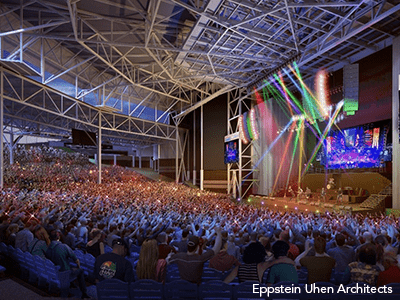
Music lovers have raised the roof at Summerfest’s permanent venue since 1987. With modern stage acts requiring more vertical space, the project team had to raise the roof, too–to the tune of 26 ft.
Owner: Milwaukee World Festival, Inc. (Summerfest), Milwaukee
Architect: Eppstein Uhen Architects, Milwaukee
Structural engineer: Larson Engineering, Inc., Wauwatosa, Wis.
Fabricator: Ace Iron and Steel, Inc., Milwaukee *AISC full member*
General contractor: Hunzinger Construction, Brookfield, Wis.
Detailer: Nu-Way Drafting Corp., Wausau, Wis.
Erector: SPE, Inc., Little Chute, Wis. *AISC associate member*
Consultant: Mammoet (formerly ALE Heavy Lift), Rosharon, Texas
Judge comment: “It is truly innovative to be able to analyze the existing structure from the 80s, to be able to come up with a cost-efficient system of lifting the trusses and developing the methodology to cut them loose, keep them stable, and to be able to reattach them 26 ft higher than what was originally designed. It’s very cost-effective to reuse these existing structures as opposed to the environmental impacts of tearing them down. It’s a great example of what can be done with steel in these adaptive reuse situations.” -David Horowitz, executive vice president, AECOM Tishman
$75 MILLION TO $200 MILLION

National Award: Federal Reserve Building, Seattle
Built in 1949 and retired in 2014 due its outdated security features and minor damage sustained during a 2001 earthquake, this historic landmark now reaches for the sky with seven brand-new floors, a new seismic system, and new steel framing that accommodates the fact that the building has moved during its 70-year lifetime.
Owner: Martin Selig Real Estate, Seattle
Architect: Perkins & Will, Seattle
Structural engineer: KPFF Consulting Engineers, Seattle
Fabricator/detailer: Metals Fabrication Co., Airway Heights, Wash. *AISC full member, AISC-Certified building fabricator*
General contractor: Lease Crutcher Lewis, Seattle
Erector: The Erection Co., Arlington, Wash.
Judge comment: “The ability to connect a new structure over an existing building, and integrating seismic and lateral bracing throughout the existing building, showcases where steel has a truly unique ability to be connected and modified into an adaptive reuse of a building that otherwise could not be brought up to current codes.” -David Horowitz, executive vice president, AECOM Tishman
Merit Award: DFW High C Gates Demolition and Replacement – Core & Shell, Dallas
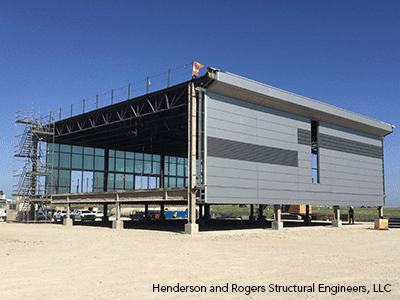
Modularization brings a new 80,000-sq.-ft concourse in for a speedy landing in a challenging site.
Owner: DFW Airport, Dallas
Architect: PGAL, Addison, Texas
Structural engineer: Henderson Rogers Structural Engineers, LLC, Houston
Fabricator/detailer/bender/roller: Miscellaneous Steel Industries, Kyle, Texas *AISC full member; AISC-Certified building fabricator*
Erector: Acero Construction Services, Kyle, Texas *AISC-Certified erector*
General contractor: The Walsh Group, Chicago
Consultant: Mammoet, Rosharon, Texas
Judge comment: “This modular installation is a great way to showcase the efficiency of using steel in a tightly constrained site in an efficient speed-to-market application–and the adaptability of this material to create these modular sections that create open, long-span areas that can be quickly and efficiently assembled.” -David Horowitz, executive vice president, AECOM Tishman
GREATER THAN $200 MILLION
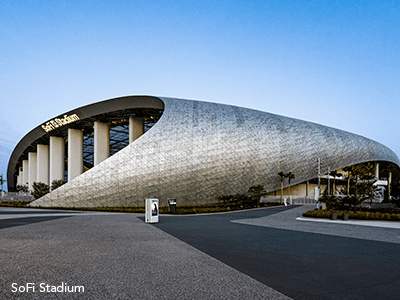
National Award: SoFi Stadium, Inglewood, Calif.
It takes true innovation to make a below-grade structure surrounded by a 100-ft-tall, mechanically stabilized earth wall feel light, but the SoFi project team did just that. That wall gives the stadium room to safely move during a seismic event at the nearby Newport-Inglewood fault.
Owner: Hollywood Park, Inglewood, Calif.
Architect: HKS Architects, Inc., Dallas
Structural engineer: Walter P Moore, San Francisco
Fabricator/erector/detailer (stadium bowl): SME Steel Contractors, West Jordan, Utah *AISC full member, AISC-Certified building fabricator and erector*
General contractor: Turner Hunt Joint Venture, Inglewood, Calif.
Judge comment: “It’s really a special project, and its setting is really thoughtful. The use of the structural steel is almost overwhelming because it in many ways feels as grand and as spectacular as any of the great churches that you may have been in–I hate to sound like I’m saying that it’s a church because it’s a sporting facility, but in many ways it has a magical quality to it. There’s a lightness to it that really elevates the spirit. It’s a dramatic experience.” -Anders Lasater, AIA, architect and principal, Anders Lasater Architects
Merit Award: Climate Pledge Arena, Seattle
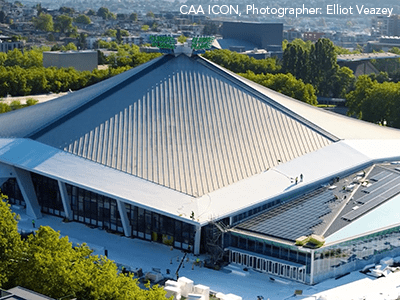
The new home of the Seattle Kraken scores a hat trick: the near-total demolition of the existing structure and construction of a largely below-grade arena while keeping the landmarked facade and iconic roof intact, completed to meet the NHL schedule, with a commitment to being the first net-zero certified arena in the world.
Owner: Oak View Group, Los Angeles
Owner’s representative: CAA ICON, Denver
Architect: Populous, Kansas City, Mo.
Structural engineer: Thornton Tomasetti, Inc., Kansas City, Mo.
Fabricator/detailer: LeJeune Steel Company, Minneapolis *AISC full member, AISC-Certified building fabricator*
General contractor: Mortenson, Kirkland, Wash.
Erector: Danny’s Construction Company *AISC associate member, AISC-Certified erector*
Civil engineer: DCI Engineers, Seattle
Judge comment: “The challenge on this project was taking an existing structure, trying to keep the facade and the roof in place while the interior was gutted. There was excavation and an intense amount of shoring to keep the project stable during the construction process and do that on a very short timeframe. That succeeded in large part thanks to early involvement of the structural steel contractor, moving a lot of the decision-making earlier in the timeline of the project and allowing some of the coordination issues to go away before they would have even come up: during construction. There’s a lot of value in steel and a lot of things we can brag about with steel, and this is just a case where that shines.“ -Mark Trimble, senior vice president, American Institute of Steel Construction
Merit Award: Moynihan Train Hall, New York
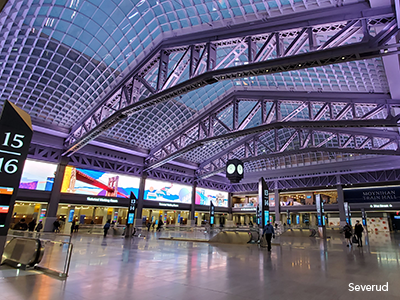
New York once again has a grand rail entrance. The Moynihan Train Hall expands Penn Station into the old James A. Farley Post Office, built in 1912–fortunately, with a steel frame. The project team modified 4,000 tons of existing steel and added 6,000 tons more to transform the 20th-century postal building into a 21st-century transportation hub–and an icon for years to come.
Owner: New York State/Empire State Development, New York
Architect: Skidmore, Owings & Merrill, New York
Structural engineer: Severud Associates Consulting Engineers, PC, New York
General contractors: Vornado Realty Trust, The Related Companies, and Skanska, East Elmhurst, N.Y.
Judge comment: “What was fascinating is that the structure, which had been perhaps wrapped in plaster for 100-plus years, is now unwrapped and has been exposed to view and becomes part of the sculpture of this beautiful space. It shows the resilience of steel: You can take that 110-year-old truss and still keep it working.” -Helen Torres, SE, PE, LEED AP, president and founder, Helen Torres & Associates
SCULPTURE/ART INSTALLATION/NON-BUILDING STRUCTURE
Merit Award: Michael and Quirsis Riney Primate Canopy Trails, St. Louis
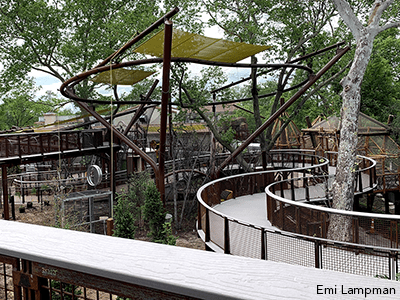
The project team behind the Michael and Quirsis Riney Primate Canopy Trails weren’t monkeying around when it came to seamlessly interweaving steel paths and climbing structures with live trees and other natural elements to give visitors a treetop experience–but the real star of the show is uncoated weathering steel, which can gracefully withstand the seasonal changes of the Midwest.
Owner: Saint Louis Zoo
Architect: PGAV Destinations, St. Louis
Structural engineer: Leigh & O’Kane, Kansas City, Mo.
Fabricator: The Gateway Company of Missouri, Berkeley, Mo. *AISC full member, AISC-Certified building fabricator*
General contractor: Tarlton Corporation, St. Louis
Detailer: Nicoloff Detailing, Edwardsville, Ill.
Bender/roller: Max Weiss Company, Milwaukee *AISC associate member*
Erector: Acme Erectors Inc., St. Louis
Animal enclosure consultant: A Thru Z Consulting, Tucson, Ariz.
Judge comment: “The challenge on this project was the need to have things fit precisely at the locations where they were intended to be–that requires a lot of coordination between the fabricator, the contractor, and the detailer, and a lot of unusual layout techniques. Given the way those walkways snake through the site, the ups and downs, the almost roller-coaster-ride-type curves, I don’t think this project could have been made with anything other than steel. The way the paths are nestled through the trees seems almost natural. And with uncoated weathering steel, it just blends right into the background. It makes me wonder what those monkeys think about when they’re looking at us humans as we walk down the path, if they’re wondering if maybe we are the monkeys.” -Mark Trimble, senior vice president, American Institute of Steel Construction
Take a virtual tour of the primate canopy trails.
AISC would like to thank this year’s judges for their dedication and enthusiasm:
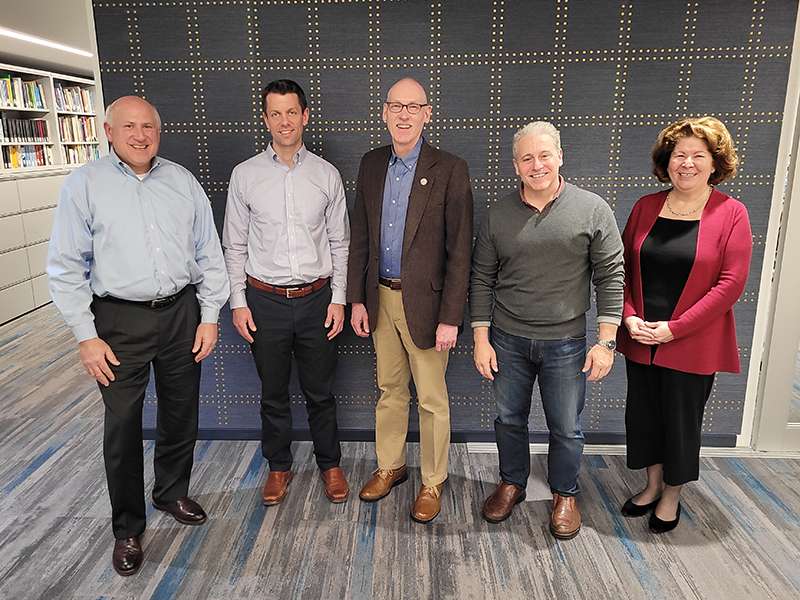
(from Left)
- David Horowitz, Executive Vice President at Tishman Construction
- Jim Foreman, PE, SE, Senior Project Engineer at Martin/Martin Consulting Engineers
- Mark Trimble, PE, Senior Vice President at AISC
- Anders Lasater, AIA, CEO, Principal Architect at Anders Lasater Architects
- Helen Torres, SE, PE, President and Founder at Helen Torres & Associates Structural Engineers
###
For more information contact:
Dani Friedland
Director of Marketing Communications
773.636.8535
[email protected]
American Institute of Steel Construction
The American Institute of Steel Construction, headquartered in Chicago, is a non-partisan, not-for-profit technical institute and trade association established in 1921 to serve the structural steel design community and construction industry. AISC’s mission is to make structural steel the material of choice by being the leader in structural steel-related technical and market-building activities, including specification and code development, research, education, technical assistance, quality certification, standardization, market development, and advocacy. AISC has a long tradition of service to the steel construction industry of providing timely and reliable information.
130 E. Randolph St, Suite 2000
Chicago IL 60601
312.670.2401
www.aisc.org


